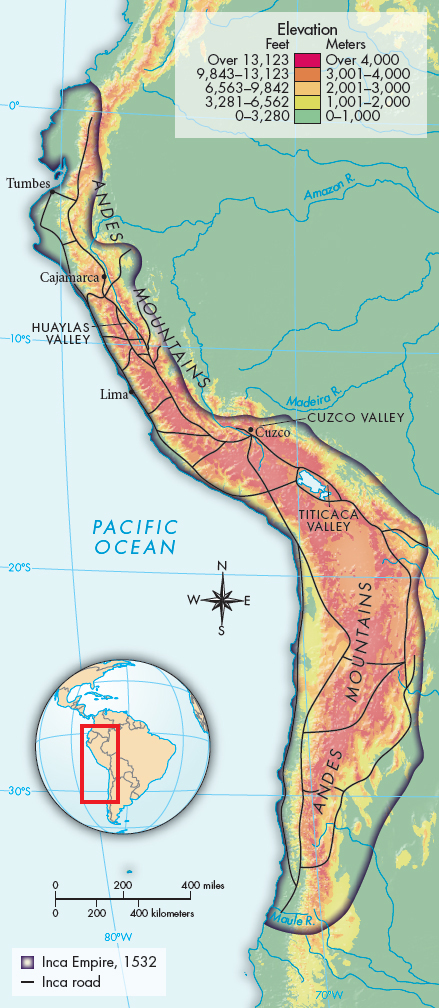The Inca Model of Empire

MAP 11.3The Inca Empire, 1532Andean peoples turned their stark mountain landscape to their advantage by settling and farming in vertical archipelagos. Settlements were located at temperate altitudes, while farming and herding took place at higher and lower altitudes.> MAPPING THE PASTANALYZING THE MAP: In what ways did Andean peoples turn their mountain landscape from an obstacle into a resource?CONNECTIONS: What types of geographic features did peoples of the Americas other than the Incas or peoples in other regions of the world adapt to their advantage? How did adaptation to their geography shape other societies?
In the Late Intermediate Period (1200–1470), the Pan-Andean influences of Wari and Tiwanaku waned. City-states around Lake Titicaca competed and fought with each other. The strongest ones again emerged. To the north, the Chimu claimed the legacy of the Moche and Wari. To the south, the city of Cuzco became the hub of a growing kingdom under the hereditary control of the Inca (Map 11.3). According to their religious, the Inca rulers invented civilization. In reality, they inherited it from the civilizations of the Titicaca basin and the Chimu in the northern coast.
From the 1420s until 1438 Viracocha Inca emerged as the first Inca leader to attempt permanent conquest. Unlike the sinchis (SEEN-cheese), or kings, of earlier and rival city-states, Viracocha Inca fashioned himself an emperor, and in adopting the name Viracocha, connected himself to the god of creation. In 1438 rivals invaded Viracocha Inca’s territories and he fled. His son, Pachacuti, remained in Cuzco and fended off the invaders. He crowned himself emperor and embarked on a campaign of conquest. Pachacuti Inca (r. 1438–1471) conquered the Chimu near the end of his reign.
After conquering the Chimu, Pachacuti instituted practices that quickly expanded the empire across the Andes. He combined Andean ancestor worship with the Chimu system of a split inheritance, a combination that drove swift territorial expansion and transformed Tawantinsuyu into one of the largest empires in the world within less than fifty years. Under the system of ancestor worship, the Incas believed the dead emperor’s spirit was still present, and they venerated him through his mummy. Split inheritance meant that the dead emperor retained all the lands he had conquered, commanded the loyalty of all his subjects, and continued to receive tribute. A panaqa (pan-AH-kah), a trust formed by his closest relatives, managed both the cult of his mummy and his temporal affairs.
When the ruler died, his corpse was preserved as a mummy in elaborate clothing and housed in a sacred and magnificent chamber. The panaqa of descendants of each dead ruler managed his lands and used his income to care for his mummy, maintain his cult, and support themselves, all at great expense. One of his sons was named the new Inca emperor. He received the title, but not the lands and tribute — nor, for that matter, the direct allegiance of the nobility, bound as it was to the deceased ruler. The new emperor built his own power and wealth by conquering new lands.
